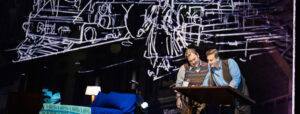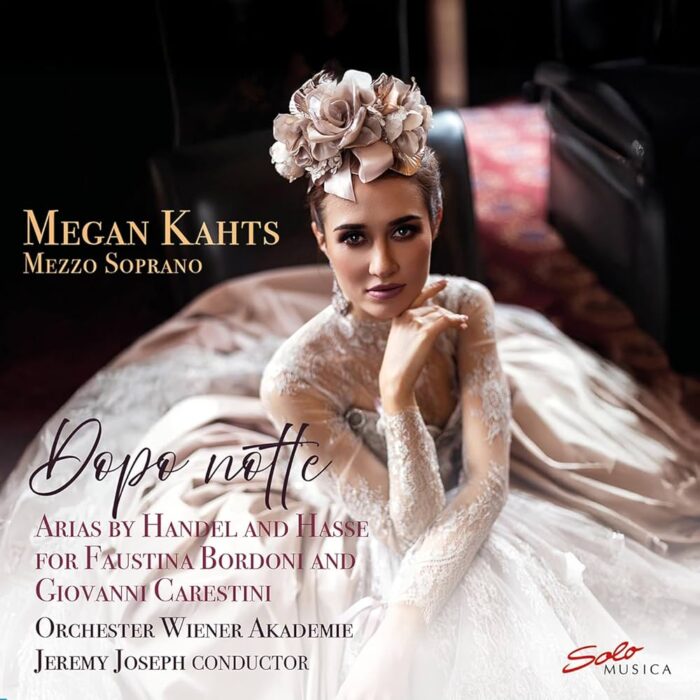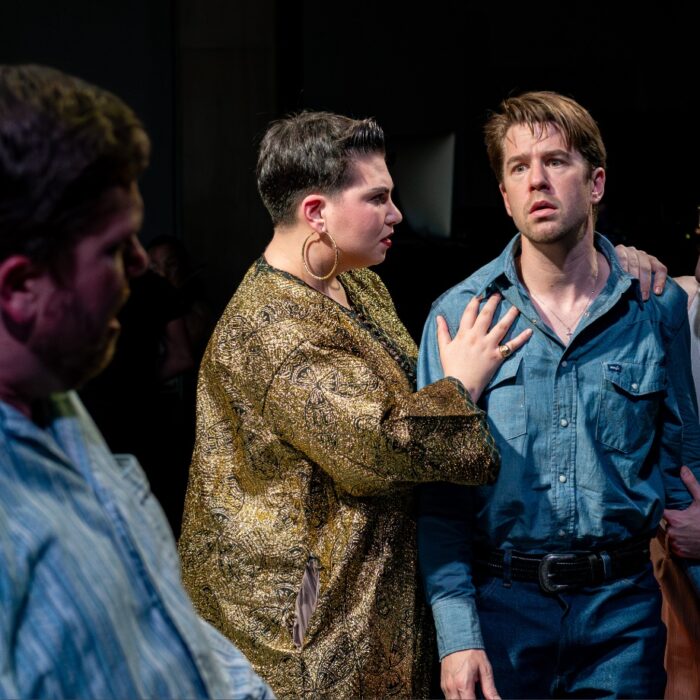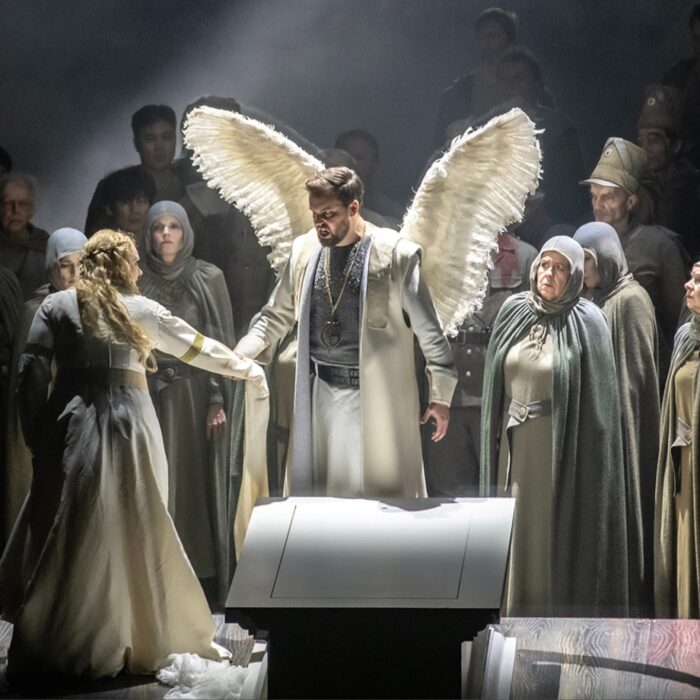
Metropolitan Opera 2025-26 Review: The Amazing Adventures of Kavalier and Clay
By David Salazar(Credit: Evan Zimmerman / Met Opera)
An immigrant and a gay man join forces to create art that defeats Nazis.
While this simple sentence reduces all the complexities at play in “The Amazing Adventures of Kavalier and Clay,” it also gets to the core of a battle that permeates to this day and provides us with the kind of hope that only art can provide. And Mason Bates and Gene Scheer’s new opera, receiving its Metropolitan Opera premiere (it was previously performed in a different version at Indiana University) delivers.
As is customary before any opening night performance, music director Yannick Nézet-Séguin led the Met Opera Orchestra in the Star Spangled Banner, which had a heightened significance given the recent events transpiring in the United States. Then Peter Gelb, as per usual, took the stage to introduce the season. Gelb, never the most inspiring of public speakers, scored a massive ovation when he proclaimed “Here at the Met, we stand for freedom of artistic expression.” He might be full of contradictions regarding his leadership, but everyone knew what he meant and everyone appreciated the statement of intent. It was a crowning moment for him, but as per usual, he didn’t know when to stop and his next move might have washed away all the good feelings of his initial declaration.
Gelb went on to invite U.S. Senator Charles Schumer to the stage for… some reason. I can’t quite comprehend what the point of it was. Schumer might be the leader of the opposition to the Trump regime in the Senate, but he’s hardly an inspiring figure. Known for talking the talk more than walking the walk (in my family, we have heard Schumer’s “Go for it” high school / college graduation speech at least 12 different times over two decades), Schumer was met with jeers and boos with some audience members telling him to “do something” over his claims that we must defend the arts because they are under attack. He invoked the Jimmy Kimmel situation. He made proclamations about keeping the freedom of speech intact. These are all all things that everyone in the audience knows and cares about. But not once did he make any statement of intent on what he would do about it. I am firmly of the belief that arts and politics are intermingled, but what I am firmly against is lecturing and propaganda. Schumer’s presence was firmly the latter. Worst of all, it was completely pointless, empty posturing.
Thankfully, “The Amazing Adventures of Kavalier and Clay” was anything but that.
Heroes
Gene Scheer’s libretto, based on the Pulitzer Prize-winning novel by Michael Chabon, commences in 1939 as Josef Kavalieri prepares his escape from Nazi-infested Prague en route to New York. His plan is simple – get to the land of freedom, make some money, and send for his parents and sister Sarah. In Brooklyn, he befriends his cousin Sam Clay, a writer, and the two join forces to create a sensational comicbook hero, The Escapist, that takes the world by storm. Meanwhile, the newly christened Joe Kavalier, falls in love with Rosa Saks, an artist and activist, while Sam comes to term with his sexuality and falls for Tracy, the voice of The Escapist. But the escapism that art provides only lasts so long and tragedy eventually strikes, separating the cousins from their lovers. Eventually, art provides the avenue towards healing and the opera ends on the most hopeful of notes with a plea to “hope anyway.”
In reading the summary provided by the program, I was confused and very wary of the opera at large. Whereas the standard rep features works based on plays, which by their nature take theatrical duration into consideration, many newer pieces attempt to grapple with larger texts or formats such as film and novels, which aren’t always ideal for the reduced stage time. The results are often, overlong, convoluted plots that jump from scene to scene to the detriment of the music and character. Opera rings brightest when audiences can sit with characters, their feelings, and the music. This is not often the strength of contemporary pieces. “Kavalier and Clay” is one of the exceptions. The plot is far from convoluted and the scenes manage a solid pace that immerses us with the characters and allows the music ample time to breathe and develop. We grow to love these characters, their hopes and dreams, their relationships, and ultimately, their fates. English libretti also often stumble in their inability to find any semblance of poetic language; realism often seizes the day in all the worst ways making every sung line sound mundane and lifeless. “Kavalier and Clay,” by contrast is full of poetic gestures, and moments that truly sear into your heart and mind. By contrast, but also to the libretto’s credit, a repetitive riff on the word “Dick” during a gay party is tastefully executed and hilarious at the same time.
It isn’t perfect structurally. Part one flies by but the second half, despite being 30 minutes shorter and in part due to its decidedly darker tone, tends to slow to a crawl near the end. The ending, however, redeems everything.
A major part of that comes down to Mason Bates, who creates a score that often feels like it is invoking a 1940s Hollywood film. The openings of Act one and Act two thunder with oppressive horns before New York bustles with jazz music. Electronics and the mandolin make up a major part of the aural tapestry and transitions are often embodied by propulsive ostinatos that hint at Phillip Glass but retain a wholly unique character. Most operas that attempt to marry this many styles and genres often fall apart in their lack of cohesion, but Bates has such a strong handle on scene transitions and intentions that his music-setting never falters.
What’s more, his vocal lines are a rarity in contemporary opera. Singers get opportunities at long lyrical lines in their arias and duets, punctuated by tasteful use of high notes. Kavalier and Rosa get a gorgeous love duet in Act one, during which their voices, NOT the orchestra, guide the way. Meanwhile, Tracy and Sam’s love scene is full of frenetic orchestration, hinting at “Tristan und Isolde’s” erotic explosion in Act two of that opera. Most important of all, the use of orchestration manages a solid balance for those solo lines, the singers always coming through clearly. Unlike other composers, who seem to give prevalence to the orchestral storytelling with the singers as other instruments in the overall tapestry, Bates aims to balance the two, allowing for an experience that grounds us in the characters without ever overwhelming the senses.
This is a tricky balance to strike when you consider Bartlett Sher’s production, a feast for the eyes from start to finish.
A Visual Feast
The title of the piece stands proudly projected on stage before a single note has been played. But then, projections take over, establishing 1939 and Prague. Two towering statues stand tall amidst a rain-drenched night, the world of classic film noir. After Kavalier escapes Nazi patrol, we get an incredible animation of his journey across the globe before setting us into a brick-laden street of Brooklyn with its livelier colors. Kavalier’s initial drawings are animated on a large screen and eventually, this morphs into full-on displays of their hero’s birth and, in arguably the finest scene of the entire opera, a radio play rife with comic strips.
I spotlight this scene because it embodies what Sher does so well in this opera. The singers might be on stage singing into a mic, but their minimal movements ensure that our attention is always on the comic strips in the background. Should we want to interact with the singers again, the strips remain there long enough for our eyes to wander back and forth. In this sense, the scenes are always doing more than one thing at once, but never is the focus lacking in clarity. Sher is always directing our eyes from moment to moment. In large ensemble scenes, such as the finale of the first act, when Kavalier will find out about a major tragedy, he is placed upstage but always visible to the audience as he prepares his magic trick. The captive audience always surrounds him. Meanwhile, Sam and Rosa are downstage, coming to terms with how they will break the news to him. Two dramas happening at once, the actions so specific and pointed that neither ever takes from the other. When the two dramas collide, the scene aptly explodes into focused emotion, bringing down the curtain cathartically. At the top of the second act, Kavalier imagines a conversation between his sister and the Nazi officer. He remains stage left with a wall projecting the images of the cards he is holding. Initially we see The Escapist bashing a Nazi, but when he finds a post card calling for army recruits, that image flashes on screen. Meanwhile, the entire blocking between him and the Nazi officer remains focused with the officer only interacting with Kavalier on his small strip of stage.
There’s a turntable. Shocker, right? BUT, it’s used ONCE and tastefully, transitioning us from New York to war-ridden Europe to connect the two storylines in a moment of emotional turmoil. Transitions are beautifully executed using a square iris effect akin to movies of old.
I can’t sing enough praises about what Sher achieves here in what might be his finest opera production to date. Moreover, the use of new technology has never been more polished or enticing in any opera the Met has produced thus far.
Mesmerizing Cast
The lynchpin of all is the sensational cast that the Met has brought together. As the titular heroes, Andrzej Filończyk and Miles Mykkanen were the pillars on which the entire enterprise rose. As Kavalier, Filończyk displayed a rich, glorious, and muscular vocal line often extending into the upper reaches. He was particularly potent in his love duet with mezzo-soprano Sun-Ly Pierce, taking on the role of Rosa. During this scene, the two melded their voices and caressed lines together impeccably. This moment, revealed Kavalier’s gentler side, which was often contrasted with a more brusque nature, particularly at the close of the first Act when he learns of his sister’s death or the top of Act two where he fights with his guilt over her passing. In the opera’s later segments, he scaled back the aggressive sound for a more inward approach, drawing the listener in. Props to his also emphasizing Kavalier’s accent as a foreigner. It’s a tricky feat that could easily turn into exaggeration and ridicule, but the baritone managed it authentically and responsibly.
Where Filończyk’s Kavalier was earthier, Mykkanen’s tenor allowed Clay to be the sunshine of the piece. He brought warmth throughout the initial interactions with Kavalier, which juxtaposed nicely with his more timid interactions with Edward Nelson’s Tracy. The character gets his low point after an FBI raid on a gay party and the tenor’s ensuing lament saw his voice take on a more aggressive quality. Nonetheless, together with Rosa, he finds a way forward and in the opera’s closing scenes, Mykkanen gets some of the warmest moments onstage as he cares for the young Sarah and then rushes to hug his long-lost cousin. It’s this moment in particular that proved most cathartic, the two heroes of the piece allowed redemption together.
Edward Nelson was a standout as Tracy, illuminating the stage with tremendous vocal and physical confidence. We see this during his first appearance on the radio show, but especially during his love scene with Clay when, following a timid first kiss, he takes him in his arms and goes for it. During the gay party, he gets a major solo that drew tremendous laughs. After all this display of male confidence, his death, a more quiet affair in the arms of Kavalier, was heart-breaking. Here the baritone’s voice proved a far cry from his more muscular approach, the sound thinned out and gentle.
Sun-Ly Pierce also displayed a sweet mezzo throughout as Rosa, though the role gives her ample opportunity to dig in and explode with forte sound. Her duet with Filończyk was a highlight, as was her aria during the broadcast when she rallies help for children in Europe.
Efraín Solís debuted in the role of Salvador Dalí. Yes, that sentence is correct. The baritone was sensational drawing laugh after laugh as he danced about the stage as the eccentric genius, getting one of the most memorable lines of the entire show when he remarks on the difference between a mad man and himself, noting that while the mad man thinks he’s sane, he, Dalí, knows that neither is.
Lauren Snouffer plays the crucial role of Sarah Kavalier. Her soprano introduces the entire show and returns throughout as a reminder to the opera’s central protagonist to keep moving forward. Her voice shone in those opening moments, but was particularly captivating in her confrontation with Craig Colclough’s Gerhard (the nazi). Colclough’s bass-baritone eschewed any beauty in sound, instead opting for pointedness and aggression.
The remainder of the cast, which featured Eve Gigliotti, Richard Croft, Patrick Carfizzi, Ellie Dehn, Nathan Carlisle, John Moore, Amanda Batista, Garen McRoberts, Jonathan Elmore, Ross Benoliel, Ned Hanlon, Jerimy Rivera, Steven M. Warnock, Helen Rtveliashvili Mangan, and Bonnie Wright, all made their presences felt.
Then there’s Yannick Nézet-Séguin, who continues to excel in contemporary works. The conductor was brilliant throughout, managing a wonderful balance between the singers and the pit that allowed the drama to ebb and flow. The opening notes of Act two, with their violent thrust, will not be easily forgotten. Neither will the ending, especially the explosion of sound of vibrant strings at the very moment where our two protagonist jumped into each other’s arms. The opera itself already has the tools to be brilliant, but Nézet-Séguin managed the pace throughout extremely well and really allowed the voices to be heard.
In all, this was arguably the most successful opening night the company has had since the pandemic. The Charles Schumer flub aside, the opera itself emphasized that art not only has a place in a declining society, but is crucial to it. As political forces continue to threaten our most fundamental rights, art stands as a beacon of expression. It stands as our greatest form of resistance; as a source of nourishment; as inspiration; as hope that no matter what happens, we can and will move forward. Most importantly, any of us, even the most marginalized, like immigrants and members of the LGBTQ community, can create art. That’s what gives it its power. It doesn’t belong to anyone. It belongs to all of us.
Near the end of the opera, Rosa declares, “The world will always be broken. Repair it anyway.” Art like “The Amazing Adventures of Kavalier and Clay” is what allows us to do so.


